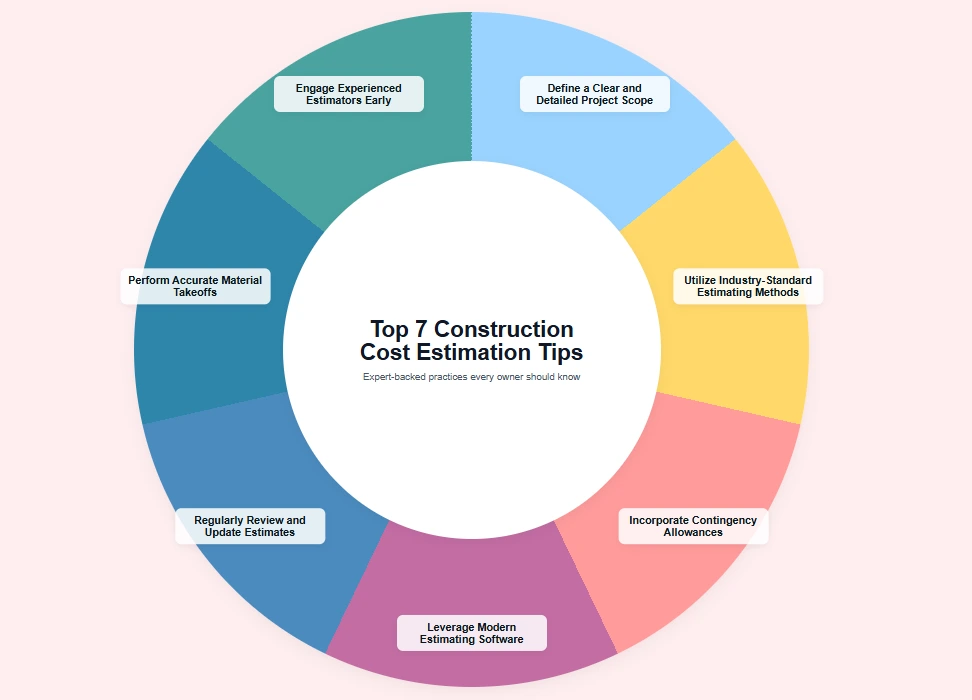Construction cost estimation isn’t just about crunching numbers — it’s about strategic planning, precision, and foresight. In this article, industry experts reveal the secrets of Construction Estimation that make estimates more accurate and reliable. From defining clear project scopes to leveraging modern software, these insights will help you control costs, reduce risks, and achieve smoother project execution.
Table of Contents
Define a Clear and Detailed Project Scope
“A comprehensive scope of work is the cornerstone of an accurate estimate. It ensures that all parties have a mutual understanding of the project’s requirements, reducing ambiguities and potential disputes.”
— Paul Wheaton, Construction Estimating Expert (McCormick Systems)
Explanation
A well-defined project scope outlines all deliverables, timelines, and quality standards. This clarity helps estimators calculate precise material quantities, labor hours, and equipment needs, leading to more accurate cost projections.
Beneficiaries
- Project Owners: Receive accurate budgets and timelines.
- Contractors: Reduce the risk of scope creep and associated costs.
- Clients: Experience smoother project execution with fewer misunderstandings.
Real-Time Application
On a commercial building project in Florida, the james and contractor used a detailed scope document before bidding. This included all floor layouts, material specifications, and finish types. Because of this, the estimate matched the final costs within 2%, avoiding disputes and unnecessary change orders.
Utilize Industry-Standard Estimating Methods
“Employing standardized estimating methods like Unit Cost, Assembly, and Parametric Estimating ensures consistency and reliability in cost projections.”
— RSMeans Construction Estimating Guide (rsmeans)
Explanation
Standardized methods provide frameworks for estimating costs based on historical data and industry benchmarks. These approaches help estimators account for various project variables and enhance the accuracy of their forecasts.
Beneficiaries
- Estimators: Achieve consistency and reliability in their estimates.
- Project Owners: Receive well-founded cost projections.
- Stakeholders: Benefit from transparent and justifiable budgets.
Real-Time Application
For a residential housing development in Texas, the estimator used the Unit Cost method with RSMeans data to calculate material and labor costs. This method helped the owner stay within 3% of the projected budget despite multiple design changes during construction.
Incorporate Contingency Allowances
“Including contingency allowances in estimates accounts for unforeseen issues, helping to prevent budget overruns.” (UtopianTakeoffs)
Explanation
Contingency allowances are funds set aside to address unexpected challenges or changes during the project. By incorporating these into the estimate, owners can better manage risks and maintain financial control.
Beneficiaries
- Project Owners: Mitigate financial risks associated with unforeseen issues.
- Contractors: Have a buffer to address unexpected challenges without disputes.
- Clients: Experience fewer delays and cost escalations.
Real-Time Application
During a hospital expansion in California, a 10% contingency was added to cover unexpected soil remediation costs. When unexpected foundation issues arose, the contingency fund covered the extra expenses without impacting the overall project schedule.

Leverage Modern Estimating Software
Adopting advanced estimating softwares streamlines the estimating process, improves accuracy, and enhances collaboration among project teams.”
— Estimating Edge Insights (Estimating Edge)
Explanation
Modern estimating software automates calculations, integrates real-time data, and facilitates collaboration among stakeholders. This technology reduces human errors and accelerates the estimating process, leading to more efficient project planning.
Beneficiaries
- Estimators: Save time and reduce errors in the estimating process.
- Project Owners: Receive timely and accurate estimates.
- Stakeholders: Benefit from improved communication and coordination.
Real-Time Application
On a high-rise office project in New York, the contractor Alien used software to update quantities and costs daily. This allowed the owner to track spending in real-time and make informed decisions about value engineering without project delays.
Regularly Review and Update Estimates
“Continuous review and adjustment of estimates throughout the project lifecycle ensure that cost projections remain aligned with actual expenditures.”
— Rhumbix Construction Estimating Tips (Rhumbix)
Explanation
Regularly updating estimates allows for the identification of cost variances and the implementation of corrective actions. This proactive approach helps keep the project within budget and on schedule.
Beneficiaries
- Project Owners: Maintain financial control and project timelines.
- Contractors: Address issues promptly, preventing major cost overruns.
- Clients: Experience projects that adhere to agreed-upon budgets and schedules.
Real-Time Application
During a shopping mall renovation in Chicago, weekly review meetings allowed the project team to update estimates as material costs fluctuated. This proactive approach prevented a potential $120,000 budget overrun and kept the project on schedule.
Perform Accurate Material Takeoffs
“Accurate material takeoffs are essential to prevent overordering or shortages, which can significantly affect project costs and schedules.” (agc)
Explanation
Material takeoffs involve detailed counting and measurement of materials needed for construction. Accurate takeoffs ensure that quantities and costs reflect actual project needs, reducing waste and unexpected expenses.
Beneficiaries
- Project Owners: Avoid unnecessary expenses due to overordering.
- Contractors: Reduce delays from material shortages.
- Clients: Experience smoother workflow and on-time completion.
Real-Time Application
On a residential apartment project in Floridia, detailed material takeoffs using laser measurement tools helped the contractor order exactly the needed amount of concrete and steel. This minimized waste and saved the owner over $25,000 in material costs.
Engage Experienced Estimators Early
“Involving experienced estimators at the planning stage improves accuracy, identifies risks early, and optimizes project budgets.”
(constructconnect)
Explanation
Early involvement of skilled estimators allows for realistic cost projections, better risk assessment, and informed decision-making. Their experience can foresee potential challenges before construction begins.
Beneficiaries
- Project Owners: Receive reliable budget and schedule projections.
- Contractors: Can plan resource allocation efficiently.
- Clients: Avoid costly surprises during construction.
Real-Time Application
For a corporate headquarters project in Atlanta, experienced estimators were consulted during the design phase. They identified a potential HVAC system cost overrun early and recommended design modifications, saving the owner nearly $150,000 and keeping the project on schedule.
Conclusion-Hidden Secrets of Construction Estimation
Implementing these expert-recommended practices—defining a clear project scope, utilizing standardized estimating methods, incorporating contingency allowances, leveraging modern estimating software, and regularly reviewing estimates—can significantly enhance the accuracy and reliability of construction cost projections. By adopting these strategies, owners can better manage their projects, mitigate risks, and achieve successful project outcomes.
If you require further assistance or a tailored version of this article, feel free to ask!

